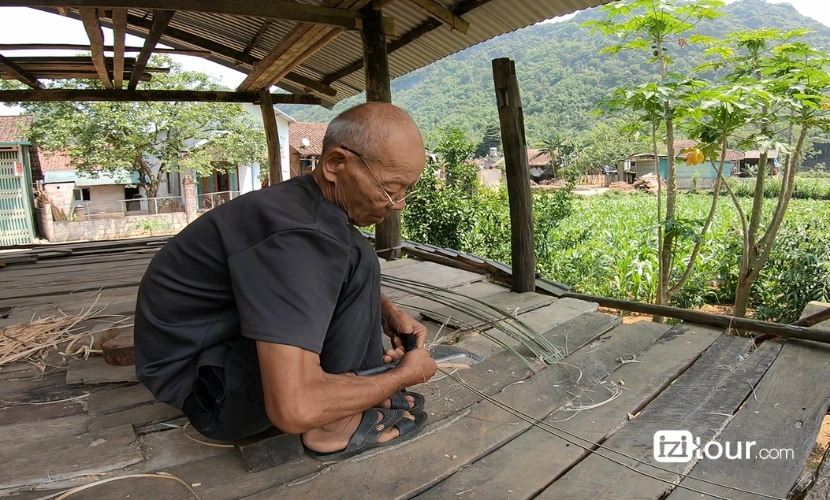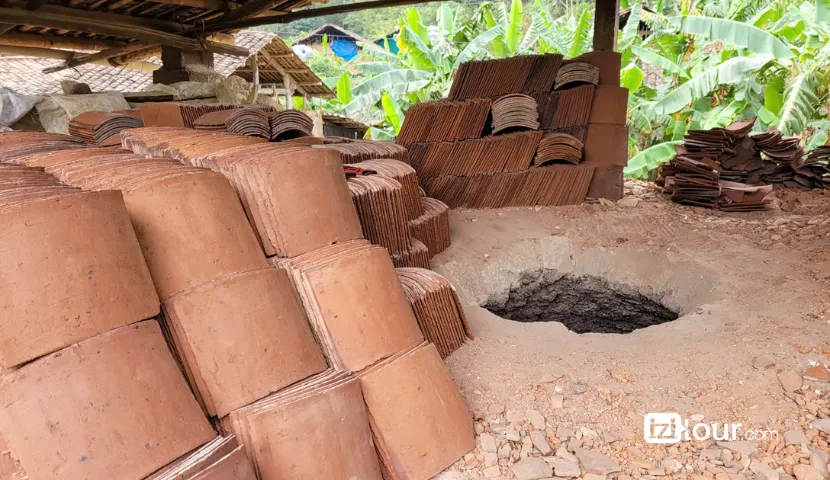Cao Bang is located in the Northern mountainous region of Vietnam, where many ethnic minorities reside. For generations, local communities have cultivated their traditional crafts, creating a unique cultural identity that continues to develop today. There have been times when they have faced the risk of loss, but handicraft products still have a special positions. Handicrafts in Cao Bang remain a vital part of daily life and local economy. These crafts not only serve functional purposes but also attract travelers who wish to explore and learn about the authentic heritage of this beautiful province.
In this article, we'll take a closer look at some of the most renowned traditional craft villages in Cao Bang, where cultural values are preserved through skilled hands and heartfelt dedication.
- 1. Phia Thap Village – The art of natural incense making
- 2. Pac Rang Village – A legacy of traditional blacksmithing
- 3. Doai Khon Village – The art of bamboo and rattan weaving
- 4. Lung Ri Village – Preserving yin-yang roof tile making
- 5. Dia Tren Village – Traditional handmade paper craft
- 6. Villages in Hoa Tham - Preserving the art of brocade and batik
1. Phia Thap Village – The art of natural incense making
Located at the foot of Pha Hung Mountain in Quoc Dan commune, Quang Uyen district, Phia Thap village is a famous incense-making village primarily inhabited by the Nung ethnic group. What makes Phia Thap incense different from others is that it's made entirely from natural materials found in the limestone mountains. Apricot wood is used for the sticks, while sawdust and the leaves of a native tree are turned into a sticky binder.
The structure of Nung people's incense is divided into two parts: the stick and the incense powder. The process of making it involves dipping bamboo or rattan sticks (about 40 cm in length) into a water mixture made from ground leaves to create the adhesive, followed by coating them in incense powder, a blend of natural leaf powder and sawdust. This must be done quickly to ensure even coverage and a firm, round finish.

Nung incense is not dried in an oven but is dried naturally under sunshine
The incense is then dried naturally under the sun, not in ovens, preserving its delicate fragrance and eco-friendly nature. Visiting the village, you'll witness vibrant scenes of incense bundles drying in backyards, fields, and even along stone fences.
From young children to elders, everyone in the village can participate into the process. The half part of incense sticks will be dyed red after drying, then they are packed in small packets and ready for use. The finished incense product is sold in ethnic markets and served at spiritual tourist sites.

Everyone in the village can take part in the process of incense making.
Incense from Phia Thap village is renowned among ethnic groups in the region and has become a popular commodity in markets across Cao Bang province, thanks to its distinctive, delicate fragrance and natural ingredients. Incense production not only plays a vital role in the local economy but also helps preserve a traditional craft deeply rooted in the cultural identity of the Nung people.
>> Check out our full guide to Phia Thap village.
2. Pac Rang Village – A legacy of traditional blacksmithing
Along National Highway 3 on the way to the Ta Lung border gate, lies Pac Rang village in Phuc Sen commune. This blacksmithing village has a history of over 500 years, dating back to the Mac dynasty in the 16th century. At that time, they recruited and trained natives to become forging craftsmen. During the war period, Phuc Sen locals used iron and steel to make guns, machetes and knives in order to help Vietnamese people resist to enemy. When the country was unified, the village evolved into a place that produces high-quality agricultural tools and knives to supply the mountainous provinces with agricultural production and daily life.

Blacksmithing in Pac Rang is practiced on a household scale.
The local Nung An ethnic group continues to practice the traditional blacksmithing craft using techniques passed down for generations. The production of a complete knife involves multiple steps: cutting, forging, hardening, assembling, and grinding. Among these, hardening and assembly are what make Pac Rang knives famous for their strength and precision.
Despite facing the threat of extinction, the craft has survived thanks to passionate artisans, community tourism initiatives, and an emphasis on craftsmanship over mass production. Though priced higher than Chinese imports, even three times, the superior quality ensures that these tools remain in high demand.
Today, visitors to Pac Rang can observe the blacksmithing process, interact with craftsmen, and enjoy the serene natural surroundings of the Phuc Sen area, which includes forests and rustic homestays.
>> Learn more in our detailed article on Pac Rang Blacksmith Village.
3. Doai Khon Village – The art of bamboo and rattan weaving
Located in Ngoc Dao commune, Doai Khon village is known for its centuries-old tradition of bamboo and rattan weaving, a craft deeply embedded in the daily lives of ethnic minorities in Cao Bang. The villagers skillfully turn natural materials such as bamboo, rattan, and neohouzeaua into handmade household items like baskets, trays, mats, and storage containers.
The process begins with cutting, peeling, and soaking the bamboo and rattan to soften them, making them easier to weave into intricate patterns. What makes Doai Khon's bamboo weaving unique is its minimalist yet durable design, using techniques passed down through generations. Each piece reflects both functionality and aesthetic simplicity.

The Nung people are well known for their hard work and diligence.
One of the key attractions of visiting Doai Khon village is the opportunity for tourists to observe the weaving process firsthand. Visitors can learn about the intricate techniques involved, try their hand at weaving, and purchase authentic, handmade items directly from the artisans. This immersive experience allows tourists to appreciate the craftsmanship and culture that have been preserved for centuries in the village.
>> Discover more about bamboo and rattan weaving in Doai Khon.
4. Lung Ri Village – Preserving yin-yang roof tile making
Tucked away in the remote area of Northeast Vietnam, Lung Ri village is one of the few remaining places in Northern Vietnam where artisans continue the traditional craft of yin-yang roof tile making. These iconic tiles, named for their interlocking male-female design, are widely seen on ancient houses, pagodas and communal halls across Vietnam.

The tiles are handcrafted with highly precise dimensions.
The production of yin-yang tiles is a labor-intensive process that begins with sourcing high-quality clay from the local area. The clay is carefully shaped into the distinctive curved tiles that interlock to form a continuous roof covering, with a male and female piece fitting together in a yin-yang pattern. This design not only offers a distinct visual appeal but also provides durability and protection against the elements. After shaping, the tiles are fired in traditional kilns over a period of several days, reaching temperatures high enough to make them weather-resistant and a beautiful rustic finish.
Though modern materials have replaced traditional tiles in many areas, Lung Ri’s handmade roof tiles are still highly valued for heritage restoration projects and eco-architecture, preserving a piece of Vietnam’s architectural identity.
>> Learn more about yin-yang tile making in Lung Ri village.
5. Dia Tren Village – Traditional handmade paper craft
In the quiet corner of Cao Bang, Dia Tren village is home to the lesser-known yet fascinating craft of traditional paper making. Practiced mostly by the Nung ethnic group, the process uses the bark of native trees to produce natural, eco-friendly paper for calligraphy, ceremonial use and folk art.

Visiting the craft villages in Cao Bang, tourists will have a memorable experience.
The bark is soaked, pounded, and mixed with clean water, then poured evenly over a bamboo screen mold. After draining, the thin paper is sun-dried on flats, creating sheets that are soft, slightly textured, and naturally off-white.
In recent years, the craft has seen a revival, as locals work to preserve their heritage and adapt to modern needs. The handmade paper produced in Dia Tren is now sought after by collectors, artists, and tourists alike. Visitors to the village can learn about the paper-making process, try making their own paper, and purchase traditional paper products such as scrolls, notebooks, and decorative items.
>> Explore the art of handmade paper in Dia Tren.
6. Villages in Hoa Tham - Preserving the art of brocade and batik
Located in Nguyen Binh district, Hoa Tham commune is best known for its exquisite handmade batik on brocade, a craft deeply rooted in the traditions of the Dao Tien ethnic group. No one knows exactly when the weaving began, but for centuries, Dao women have passed down the skills of weaving and dyeing vibrant fabrics.
Traditional brocade fabrics are made from jute, linen, and indigo, all cultivated locally. The highlight of the process is the batik technique, where patterns are hand-drawn using melted beeswax on a white fabric, creating intricate, one-of-a-kind designs.

Every product, from scarves and bags to traditional clothing, is entirely handcrafted, making each piece unique. Historically, Dao girls were expected to weave their own wedding dresses, turning the art into a rite of passage. As time goes by, ready-to-wear clothing has become easily available in shops, making the time-consuming process of sewing traditional costumes less popular among the Dao Tien community. Faced with the risk of losing their brocade weaving tradition, local residents have made significant efforts to preserve and revive this cultural craft. Although modern clothing has made traditional garments less common, locals are now reviving the craft by selling brocade souvenirs to tourists. Brocade and batik products are basically used to make clothes, towels, and household textiles such as blankets, pillows, slings, etc.

Batik and brocade products have become meaningful souvenirs for visitors. The villages producing brocade and batik are located along popular tourist routes such as the Ban Gioc Waterfall, Thang Hen Lake, and Ta Lung border crossing, making them an ideal cultural stop for travelers. Shirts, bags, and other brocade items are increasingly popular among tourists, contributing to both the local economy and the preservation of traditional crafts.
Currently, most of the traditional handicraft villages in Cao Bang welcome tourists to visit and take photos. Although not yet fully equipped with modern conveniences, these villages offer an authentic experience of local culture and daily life. Travelers can stay in rustic homestays, join incraft-making activities, explorepeaceful villages surrounded by stunning nature and interact with friendly ethnic communities such as the Tay, Nung, and Dao. Visiting these villages not only bring new sensations but also helps preserve Vietnam's intangible cultural heritage.
Are you ready to discover the authentic Northern Vietnam?
>> Book a tour that combines nature, culture, and tradition:
Comment below or send us an email to [email protected] to get in touch with our local travel experts and create your custom handicraft village tour in Cao Bang.





















 TRAVELERS' CHOICE 2025
TRAVELERS' CHOICE 2025 



02 Comments
France
Are there any workshops where tourists can try making incense or weaving brocade themselves?
Vietnam
Write Reply